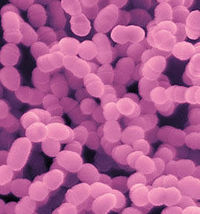Streptococcus mutans- Tooth Decay

Etiology/Bacteriology
Taxonomy
Kingdom: Bacteria | Phylum: Firmicutes | Class: Bacilli | Order: Lactobacillales | Family: Streptococcaceae | Genus: Streptococcus | Species: S. mutans
Description
Streptococcus mutans are gram-positive cocci shaped bacteria. These facultative anaerobes are commonly found in the human oral cavity and is a significant contributor to tooth decay. The result of decay can greatly effect the overall health of the individual. (http://en.wikipedia.org/wiki/Streptococcus_mutans) S. mutans are mesophilic and grow at temperatures between 18-40 degrees Celsius.(http://www.whatarebacteria.com/streptococcus-mutans/) Streptococcus mutans is a cariogenic microorganism that breaks down sugar for energy and produces an acidic environment, which demineralizes the superficial structure of the tooth. The result of the conversion disintegrates the coating of the tooth then later dissolves the Calcium molecule creating a hole. Transmission of S. mutans can be found in people of all ages although it is more common for infants and children. The transfer of genotypes are responsible for the transmission of S. mutans from mothers to their children although, there is a genotypic variation from one population to the next. (http://www.podj.com.pk/Dec_2012/p-28.pdf)
Pathogenesis
Transmission
Streptococcus mutans is considered to be part of the "norman" flora of the human mouth, which is associated with dental caries also known as tooth decay. Dental caries is an infectious and communicable dental disease that effects people of all ages. Streptococcus mutans can be passed from one person to the next via horizontal or vertical transmission. The transmission route of Streptococcus mutans is to colonize itself among human hosts. Children and infants are more prone to the diagnosis of Streptococcus mutans and studies show that many receive it from their primary caregivers. (http://www.podj.com.pk/Dec_2012/p-28.pdf) S. mutans favors hard non shedding surfaces to establish permanent colonies, which implies that levels of S. mutans are undetected in infants until the primary teeth extravasate. Although, recent studies have shown that S. mutans is able to colonize the furrows of the tongue in pre-denate infants. Typically between the ages of one and two, teeth erupt, which allows S. mutans to establish flourishing colonies on teeth, and causes cavities. The indication of cavity formation is the appearance of detectable levels of bacteria on teeth. When S. mutans is detected in the furrows of the tongue it is concluded that the vertical transmission route for the bacteria from mother to child arises shortly after birth. To prove this, saliva samples of two to five year old children were taken, which revealed a high fidelity in genetic make-up of each host's S. mutans population. These experiments also concluded that plasmid DNA correlates to different rates, which primarily implys vertical transmission. Mothers with large amounts of bacteria or those who have suffered from many dental caries themselves are likely to transmit the same virulence factors to their children. When the mothers salivary S. mutans levels exceed 105 Colony Forming Units are nine times more likely to pass bacteria on to their children. (http://www.jyi.org/issue/the-role-of-streptococcus-mutans-and-oral-ecology-in-the-formation-of-dental-caries/)
Colonization
The growth and metabolism of S. mutans changes the environmental conditions in the mouth, which enables fastidious organisms to colonize them and causes the formation of dental plaque. S. mutans metabolizes sucrose to lactic acid by using the enzyme Glucansucrase. The mouth creates a highly acidic environment that allows this process and causes highly mineralized tooth enamal to be vulnerable to decay. S. mutans is a specialized organism equipped with receptors that improve adhesion to the surface of the teeth. It uses sucrose to produce a sticky extracellular dextran-based polysaccharide that allows the bacteria to adhere forming plaque. S. mutans produces dextran with the enzyme dextransucrase to form the reaction: n sucrose --------> (glucose)n + n fructose. These sugars are digested by S. mutans and produce lactic acid as an end product. The combination of acid and plaque is the causative agent of decay.(http://en.wikipedia.org/wiki/Streptococcus_mutans)
Clinical features
Diagnosis
Treatment
Prevention
It is a fact that every human has bacteria already existing in their mouth. The only prevention is to lessen the impact of the fermentation by product lactic acid. This can be accomplished by brushing, flossing and reducing the intake of refined and processed sugars. These processed sugars come in the form of sweets, colas and processed powered sweeteners. Studies have shown that rinsing one's mouth out with water can greatly reduce the probability of cavities after the consumption of these sugars. It is almost impossible to completely reduce the effects of S. mutans but there is an option to control it. (http://web.mst.edu/~microbio/bio221_2006/S_mutans.htm)
Host Immune Response
References
References
Created by {insert your names here}, students of Tyrrell Conway at the University of Oklahoma.
This template is just a general guideline of how to design your site. You are not restricted to this format, so feel free to make changes to the headings and subheadings and to add or remove sections as appropriate.
